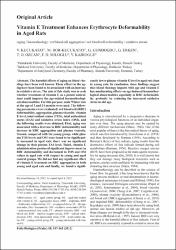Vitamin e treatment enhances erythrocyte deformability in aged rats

View/
Access
info:eu-repo/semantics/openAccessDate
2012Author
Küçükatay, VuralKüçükatay, Melek Bor
Gündoğdu, Gülşah
Erken, Gülten
Özcan, Tonguç Olgun
Miloğlu, Fatma Demirkaya
Kadıoğlu, Yücel
Metadata
Show full item recordAbstract
The harmful effects of aging on blood rheology have been well known. These effects in the aging have been found to be associated with an increase in oxidative stress. The aim of this study was to seek whether treatment of vitamin E as a potent antioxidant could improve the age-related haemorheological abnormalities. For this purpose, male Wistar rats at the age of 3 and 24 months were used. The following parameters were evaluated: red blood cell (RBC) deformability, aggregation, plasma viscosity, vitamin E level, total oxidant status (TOS), total antioxidant status (TAS) and oxidative stress index (OSI), and the following results were obtained. First, aging was associated with a decrease in RBC deformability and increase in RBC aggregation and plasma viscosity. Second, compared with the young group, while plasma TOS levels and OSI were found to be significantly increased in aged rats, there was no significant change in their plasma TAS level. Third, vitamin E administration produced significant improvement in RBC deformability and decrement in TOS and OSI values in aged rats with respect to young and aged control groups. We did not find any significant effect of vitamin E treatment on RBC aggregation in both young and aged rats and finally, we found a significantly lower plasma vitamin E level in aged rats than in young rats. In conclusion, these findings suggest that blood rheology impairs with age and vitamin E has ameliorating effects on age-induced haemorheological abnormalities especially in RBC deformability, probably by reducing the increased oxidative stress in old age.

















